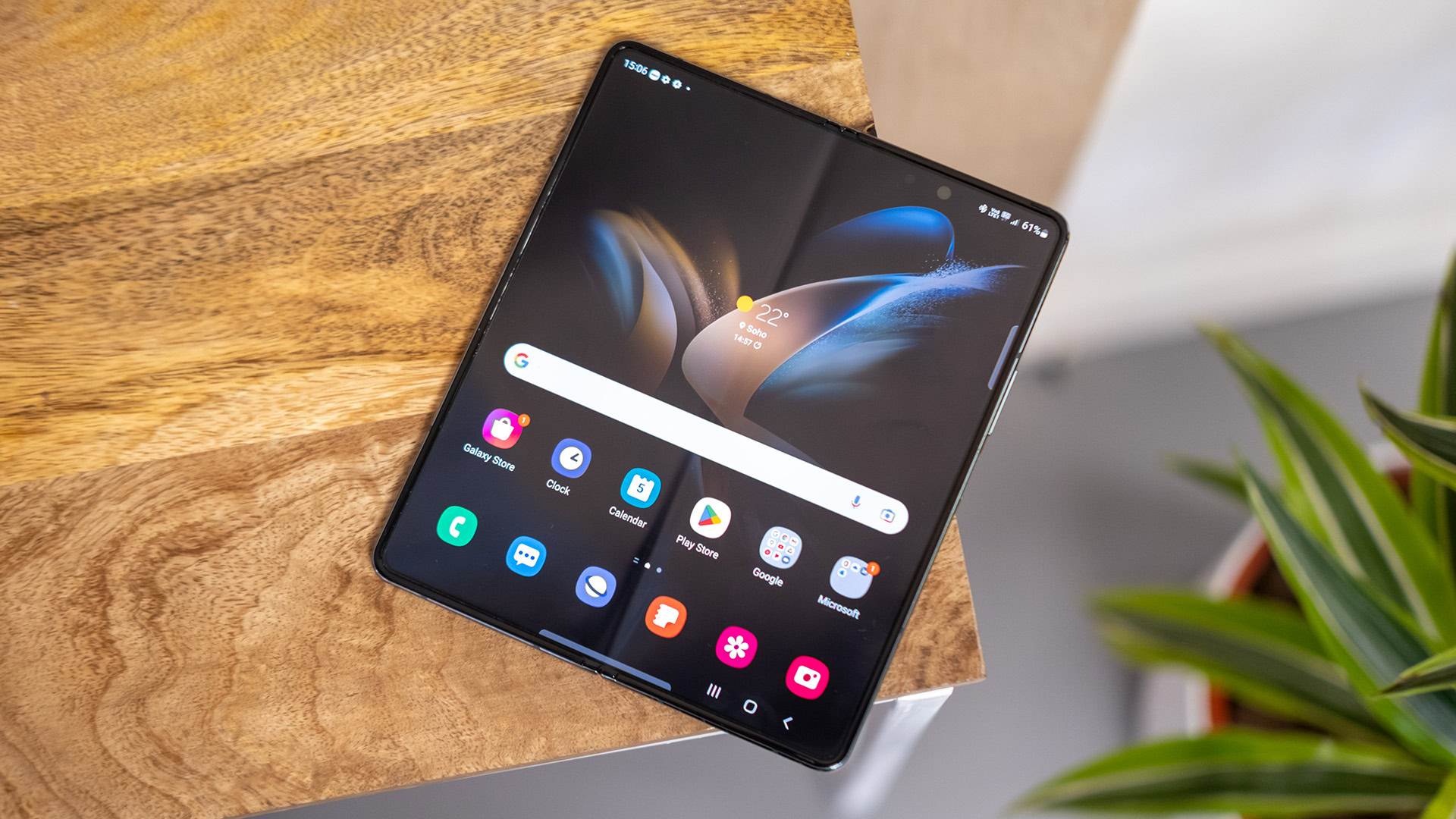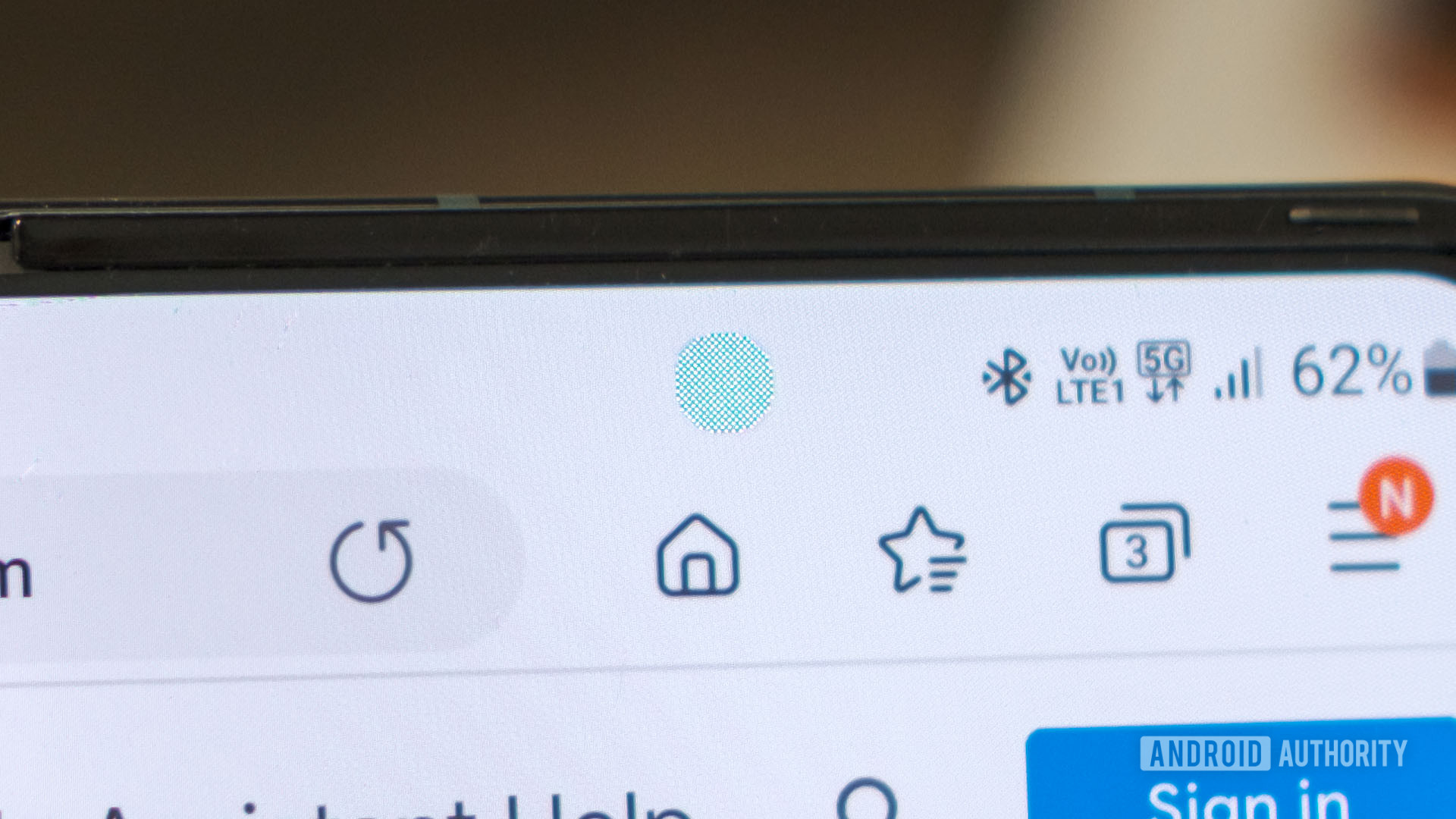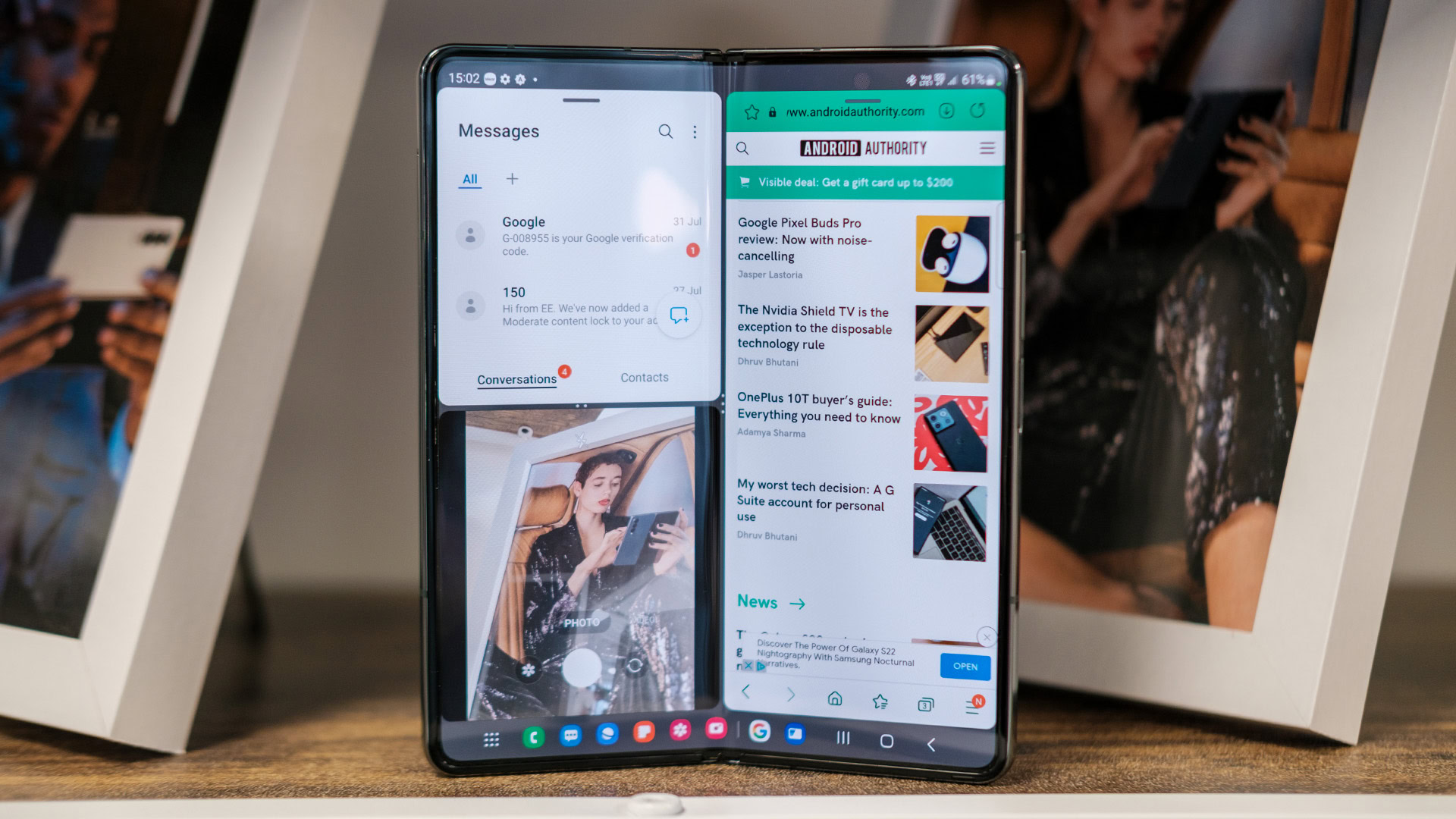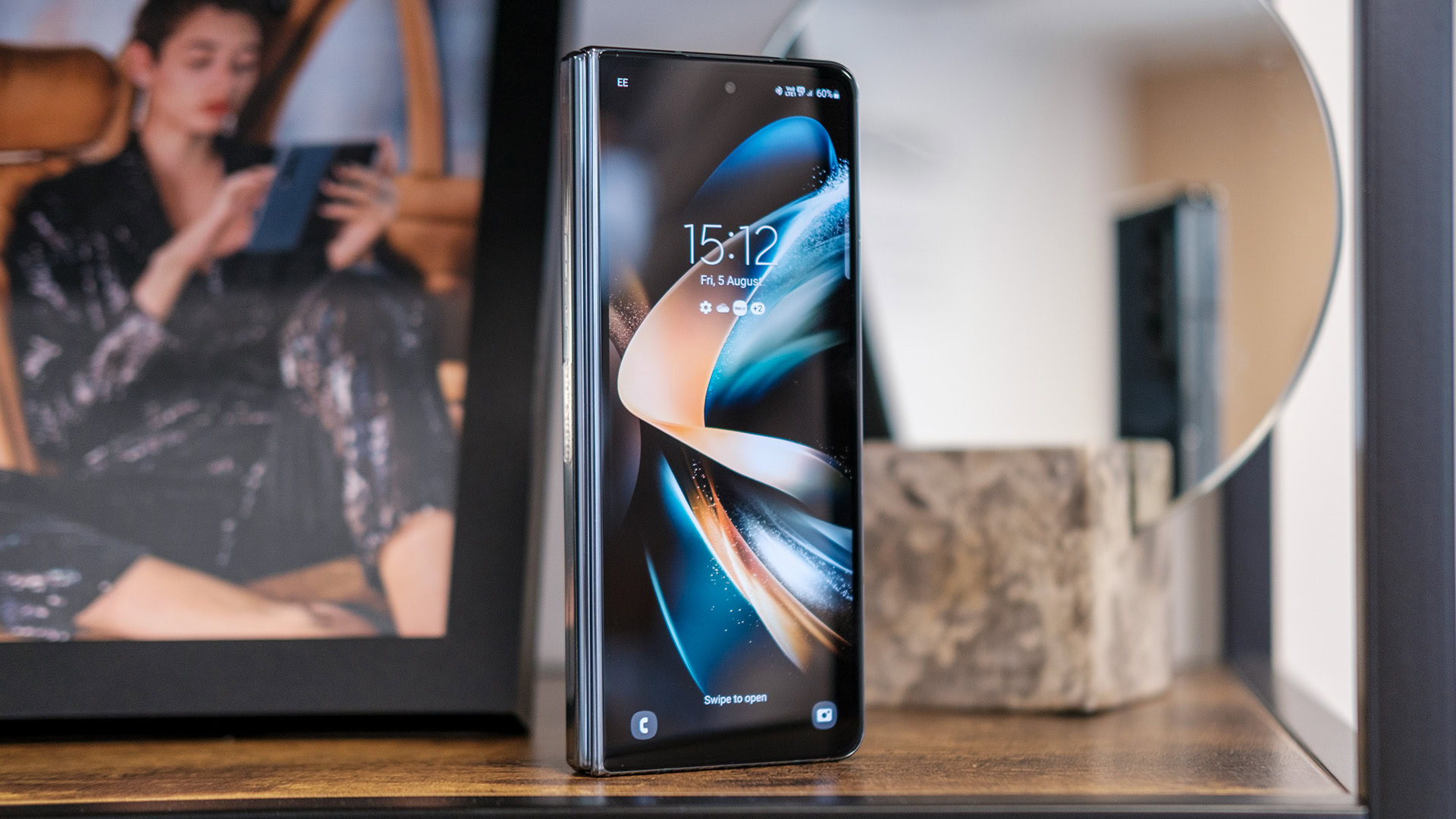Affiliate links on Android Authority may earn us a commission. Learn more.
Samsung Galaxy Z Fold 4 hands-on: Polished for prime time
August 10, 2022
Update: Check out our full Samsung Galaxy Z Fold 4 review!
If you’re after cutting-edge mobile technology, it doesn’t come any better than Samsung’s latest Galaxy Z Fold 4. Foldables are, dare we say it, one of the few areas of genuine innovation in the modern smartphone space, making new form factors and use cases an exciting possibility.
That said, there’s not a whole lot new with the Z Fold 4 at first glance. If you’ve seen a Fold before, you’ll know exactly what to expect, at least in terms of form. There’s the same productivity-focused dual display, high-quality hinge mechanism, and triple camera setup. Yes, the noticeable crease, sadly, remains in a panel that’s rated for 200,000 folds, enough to last you many years.
We’re looking at iteration rather than renovation this generation, which, considering the continued lofty asking price, may leave many searching for a compelling reason to upgrade from an existing Fold handset — not unless you’re clamoring for a slightly faster processor. Even so, Samsung made a number of small changes that add up, especially if you’re planning to purchase your first foldable. Let’s take a look at what’s new with our initial Samsung Galaxy Z Fold 4 hands-on.
A case of little nips and tucks

Once in hand, you’ll notice that the new “armor” aluminum frame is lighter than its predecessor, shaving eight grams off its weight. It’s stronger too, according to Samsung, with enhanced Gorilla Glass Victus Plus on the cover screen and back for peace of mind against drops. There’s also an IPX8 water resistance rating, which matches the Z Fold 3. Samsung is out to prove that foldables don’t have to be flimsy and has certainly curated a robust feel in the hand.
The 120Hz variable refresh rate 6.2-inch front display is marginally wider this year, with an extra 2.8mm to work with when using the phone in one hand. That doesn’t sound like a lot, and it doesn’t majorly change the phone’s feel, but it helps address a previous concern just a little. Samsung has tweaked the phone when open too, snipping 3.1mm off the verticle height and padding the width by 2.0mm. As such, the 120Hz variable refresh rate 7.6-inch main display is a little more square than last year, but again not by a meaningful amount. The panel still looks great so long as you don’t mind the little crease down the middle.
Samsung has also seen fit to offer a 1TB storage option for power users. Meanwhile, wireless charging is now available at a marginally nippier 15W, up from 10W. Not every feature has seen a facelift, though. Wired charging remains limited to 25W, for example. There’s still the necessary internal screen protector that you mustn’t remove, a side-mounted fingerprint scanner, the same 4,400mAh battery that previously raised eyebrows over battery life, and no slot to stow an S Pen (but Samsung will sell you a case with one).
The key takeaway: quality of life improvements over a wholesale revamp, but welcome improvements nonetheless. As for colors, you can have your pick from Graygreen, Phantom Black, Beige, or a Samsung Store exclusive Burgundy option.
A new camera package

For an ultra-premium smartphone, previous Z Fold handsets have been disappointing in the photography department. 2021’s phone wasn’t a bad shooter, but it lagged behind Samsung’s other flagships as well as those from rival brands. To rectify this long-standing gripe, the Galaxy Z Fold 4 features the same 50MP sensor found in the Galaxy S22 and S22 Plus, along with revamped OIS and video digital stabilization improvements. A welcome update but one that is unlikely to put the phone at the very head of the photography pack.
Samsung says the new sensor produces “23% brighter” images than last-gen, which sounds like a win for low-light photography. There’s also a new 10MP telephoto lens with 3x optical zoom (up from 2x) that bodes well for longer-range photography as well. We’ll reserve judgment until we can take the handset out for a robust photography session. Though we can ignore the 30x Space Zoom claims already; the camera definitely won’t hold up that well based on all our testing with other Samsung phones.

Samsung also revamped its under-display selfie camera. It appears to be the same image sensor as the last gen, but there’s a new scatter-type sub-pixel arrangement over the camera. I’d say it’s marginally more disguised than before, but you can still seek out the camera’s location quite easily in most lighting conditions. Thankfully, it’s not distracting enough to be a bother, but it’s still a bit of a blemish on an otherwise sleek piece of hardware.
Without the Z Flip 3 at hand to compare, I can’t vouch that the image quality is any different than the previous generation. Either way, partially blocking light from reaching the sensor means these in-display snappers can’t compete with the better selfie shooters out there. You’re still much better off using the front- rather than internal-facing camera.
Samsung Galaxy Z Fold 4: Hot or not?
Finally, foldable software that feels finished

Samsung built the Z Fold series to be a multitasking powerhouse, and the introduction of a desktop-like taskbar ups the ante in Samsung’s One UI 4.1.1 software. The feature, pictured above and below, houses all your favorite apps along the bottom of the inner display. It takes up a few extra millimeters of space than the regular navigation buttons, but it’s a completely worthwhile trade-off. After all, the Z Fold 4 isn’t exactly short of on-screen real estate.
The taskbar might seem like a trivial addition, but it’s hard to overstate how much of a positive change it makes. Support removes the software learning curve that dogged previous Folds; it’s more familiar and seamlessly blends the hybrid mobile and PC use case the Fold has always promised. For instance, you don’t have to rely on access to the Edge Panel to drag and drop apps into place. Now, your favorite apps are constantly at your fingertips, truly leveraging Samsung’s excellent drag-and-drop multi-window functionality with the ability to quickly swap things around. Like last year, the Galaxy Z Fold 4 supports three apps running in simultaneous windows, which is plenty.
Taskbar support seamlessly blends the hybrid mobile and PC use case the Fold has always promised.
Overall, this little change results in a much more intuitive experience for first-time foldable explorers, even though you’ll still have to shake the old tap to launch muscle memory that erased my multi-screen setup on a few occasions. Fortunately, taskbar support is part of Android 12L, so should appear on future foldables from other brands too. Speaking of, Samsung says the taskbar is coming to the Galaxy Z Fold 3 in an unspecified future update.
The taskbar isn’t the only new way to make the most of the phone’s multitasking features. Gesture support to quickly switch an app into a pop-up window or split the screen in two to run apps side by side is great for quickly switching between tasks without the hassle of setting up a multi-screen layout. While we’re on the subject, I should note that performance felt robust while multitasking, thanks to the Qualcomm Snapdragon 8 Plus Gen 1 processor that addresses the heat issues of its predecessor paired with 12GB RAM. We’ll have to run more robust testing in our full review to be sure, but this combination should allow the Galaxy Z Fold 4 to keep up with the needs of demanding power users.
Google’s Chrome and Gmail now support drag-and-drop functionality, allowing you to copy text, links, and pictures seamlessly between the two apps. It’s just a shame this feature doesn’t extend universally across all apps. Besides that, familiar staples, including Flex mode landscape video viewing, the rear camera selfie viewfinder, and S Pen functionality, help make the most of the Fold’s unique form factor.
Software is the glue that foldable success hinges on, and our Galaxy Z Fold 4 hands-on leaves the impression that Samsung has (almost) perfected the formula. As a bonus, Samsung promises four Android OS updates and five years of security patches — the best pledge in the business.
Samsung Galaxy Z Fold 4 specs
| Samsung Galaxy Z Fold 4 | |
|---|---|
Displays | Exterior: - 6.2-inch Dynamic AMOLED - 120Hz refresh rate - 2,316 x 904 resolution - Gorilla Glass Victus Plus Interior: - 7.6-inch Dynamic AMOLED - 120Hz refresh rate - 2,176 x 1,812 resolution - Foldable display covering |
Processor | Qualcomm Snapdragon 8 Plus Gen 1 |
RAM | 12GB |
Storage | 256, 512GB, or 1TB UFS 3.1 No expandable storage |
Power | 4,400mAh dual-battery 25W wired charging Fast Wireless Charging 2.0 Wireless PowerShare No charger in box |
Cameras | Exterior rear: - 50MP wide, 1.0μm, OIS, Dual Pixel AF, ƒ/1.8 - 12MP ultra-wide, 1.12μm, ƒ/2.2 - 10MP telephoto, 1.0μm, OIS, 3x zoom, ƒ/2.4 Exterior front: - 10MP ƒ/2.2, 1.22μm Internal UDC: - 4MP, 2.0μm, ƒ/1.8 |
Audio | Stereo speakers Dolby Atmos support No 3.5mm headphone port |
SIM | Dual nano-SIM tray eSIM support |
Biometrics | Side-mounted capacitive fingerprint sensor |
Software | Android 12 One UI 4.1 |
Dimensions and weight | Folded dimensions: - 155.1 x 67.1 x 15.8mm (measured at hinge) Unfolded dimensions: - 155.1 x 130.1 x 6.3mm Weight: - 263g |
Colors | Global: Graygreen, Phantom Black, Beige Samsung Exclusive: Burgundy |
Samsung Galaxy Z Fold 4 hands-on: Perfecting the formula

Although the core essence of the Samsung Galaxy Z Fold 4 is very familiar, there are enough little improvements to nudge the overall experience up another notch. With a better camera, lighter design, and refined software touches, this feels like the polished foldable experience we’ve been longing for all this time. It’s not a game-changing upgrade over last year’s model, but there’s enough here to entice early adopters and first-time buyers to dabble in Samsung’s latest premium foldable.
However, with prices starting at $1,800/£1,649, the Samsung Galaxy Z Fold 4 remains an opulent purchase, unlike the Galaxy Z Flip 4, which now has a more mainstream $999 retail tag. Unfortunately, there aren’t any equally new premium alternatives in the US market, or Europe for that matter.
The Galaxy Z Fold 4 feels like the polished foldable experience we've been longing for all this time
We’re still waiting on the compact OPPO Find N to appear outside of China, but it may never happen. Likewise, the HUAWEI Mate XS 2 (pre-order here), is coming to Europe for €2,000, but you’ll have to be comfortable with HUAWEI’s Harmony OS software and no Google services or apps. If you’re simply looking for the best all-around non-foldable flagships on the market, Samsung’s own Galaxy S22 Ultra ($1,199) is a great pick for a lot less.
The Samsung Galaxy Z Fold 4 is the luxury Lamborghini that, while very impressive, doesn’t necessarily beat the humdrum Prius for a daily commute. Nevertheless, if you’re willing to pay to take a technological showcase out for a spin, our Galaxy Z Fold 4 first impressions suggest the phone is shaping up to come highly recommended.

